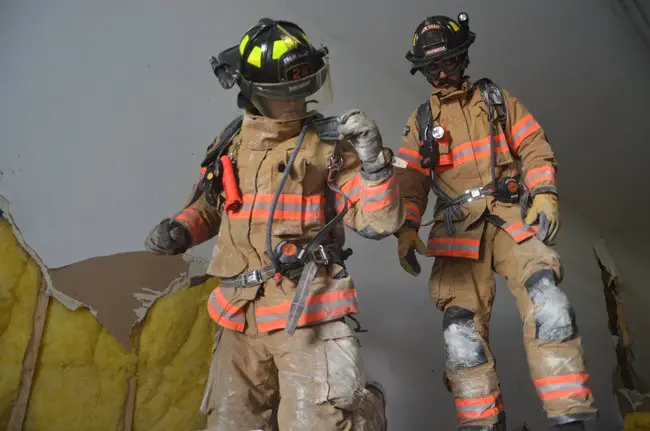
For years, properties along Bulldog Drive were the last obstacles to Palm Coast’s plans for a handsomer entrance into Town Center. Two properties in particular: at 108 and 92 Bulldog, the one-time car-repair shop and dealership owned by Gus Ajram, whose feud with the city stretched for so many years and took so many turns that the city finally and literally redrew its new road around the property, only to last year agree to buy the two buildings for $1.15 million. Four years earlier, it had bought an adjoining building and property from a different owner, at 136 Bulldog, for $800,000.
This week the city turned over the three properties to the Palm Coast Fire Department for three days of training the department rarely gets to do: using actual buildings to simulate the sort of high-intensity wall-and door-breaches necessary in emergency situations, when firefighters find themselves stuck inside a building with no avenue of escape.
It became in essence a $2 million training ground before the wrecking ball tears down the building later this month—before school starts across the street, on Aug. 24—and the properties are prepared either for public use or for commercial development. The city hopes to see retail development there in line with its eventual downtown in Town Center: “We will have a great deal of say on what gets developed there,” city spokeswoman Cindi Lane said. “We currently own it, and any transaction would include certain provisions to ensure redevelopment consistent with the City’s vision for our downtown.”
Firefighters starting Tuesday were coming in at the rate of five crews a day, so that by the time the three days of training are over, all 54 firefighters in the city department will have had hands-on training. They focused on 136 Bulldog, as they soon found that the two other buildings didn’t have subdivided rooms within with walls enough to breach.
But what 136 Bulldog gave them was plenty, including, as they also found out, the sort of surprise firefighters run into in actual calls: a wall that turns out to be anything but simple sheetrock they could slam through with their halligans and axes. An addition was built onto the structure years ago, so the inside wall turned out to be a redoubtable obstacle of cinder blocks, tile and sheetrock the firefighters had to breach. They did. (And they found a relic from the past that gave them an idea of the building’s history: an August 6, 1977 edition of the morning version of the News-Journal at the time.
Learning life-saving techniques in actual buildings rather than constructed sets.
“The guys came into this room, and even I was unaware of this,” firefighter Joey Paci, who was leading the wall-breaching training, said between sessions. “You don’t think of a concrete wall inside a building unless you can see signs from outside telling you there’s an add-on, be careful. We didn’t know. So the guys went through this sheetrock thinking it’s going to be just normal sheetrock like we saw earlier. They encounter bricks, they encounter cinder blocks, and now within these cinder blocks there’s also hazards=–is there gas lines, is there water lines, is there metal? If you look over here, there’s a hose bib.” There were also electrical lines.
That thicker wall firefighters encountered had taken 15 minutes to breach, time Paci acknowledged may not be available during an emergency, even though it would be the firefighters’ only resort. “That was the way home for them,” he said.
“Bigger cities that run a lot more fires will encounter a lot more of this stuff,” Paci said. It may happen only rarely in Palm Coast. But it does happen. “We run house fires, we run structure fires, we run building fires, but this is firefighter survival. This is the last resort, the last thing you’re going to do. Normally you have the perfect fire: your front door is open, you’re going to make entry through that front door, put the fire out, save the victim, and come out that front door. You’re the hero. That’s the perfect world. Well, now, problems happen. You go in, your front door is blocked. Your front door has fire, your front door collapses. These are the techniques we apply. We call it firefighter survival skills.”
“We’re not like New York, we’re not like Jacksonville,” Lt. Gary Potter, who led door-breaching training, said, explaining what tools and limitations firefighters have to contend with. In bigger departments, he said, entire teams are devoted to specific tasks with broad arrays of tools at their disposal. Not here, where firefighters have to develop a multiplicity of skills and survival techniques.
Firefighters Jason Lovvorn and Chris Cottle at one point went through the drill, in full gear—to simulate smoky and difficult conditions, some firefighters were to have x-ray sheets covering their masks, giving them the feel of being inside a burning structure without creating the actual hazards—as one demolished a section of wall just large enough to drag himself through then pull his partner through. It took about 90 seconds.
The advantage throughout was to conduct the training in an actual building with all its unpredictable and unfamiliar crannies, as opposed to a training ground built of sets or overly familiar to firefighters.
The videos below illustrate the two techniques of wall-breaching and door-breaching.
![]()





























David S says
Continuous training is the key to good fire dept success on the fireground !!!!!!! Know from experiance.